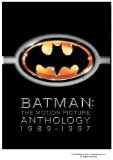| Reviews & Columns |
|
Reviews DVD TV on DVD Blu-ray 4K UHD International DVDs In Theaters Reviews by Studio Video Games Features Collector Series DVDs Easter Egg Database Interviews DVD Talk Radio Feature Articles Columns Anime Talk DVD Savant Horror DVDs The M.O.D. Squad Art House HD Talk Silent DVD
|
DVD Talk Forum |
|
|
| Resources |
|
DVD Price Search Customer Service #'s RCE Info Links |
|
Columns
|
|
|
Batman - The Motion Picture Anthology 1989-1997
Come for the Jack, stay for the nipples
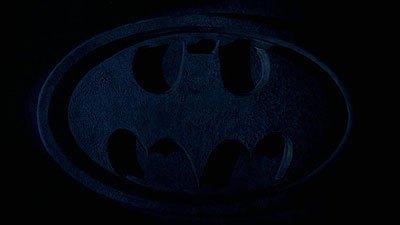
Reviewer's Bias*
Loves: Batman, Michael Keaton, Tim Burton, Val Kilmer
Likes: Jack as The Joker, Alicia Silverstone, Jim Carrey, Tommy Lee Jones
Dislikes: Danny Devito's Penguin
Hates: Batman and Robin, Joel Schumacher's work on the series
The Story So Far...
Batman came out way back in 1989, well before DVD's emergence, and Batman & Robin trailed DVD's birth by a few years. As one of the big film franchises, the four Batman films were pumped out in the format's early years, and as a result, they were not the strongest discs, lacking in special features and quality, not to mention being housed in snapper cases. The two-sided discs, in widescreen and full-frame, actually had anamorphic transfers and 5.1 audio tracks, and were available individually or in a "The Batman Legacy" box set. DVD Talk has a review of the original Batman Forever DVD here.
The Movies
Batman
Until the release of Batman Begins, Batman was the standard for film depictions of the Caped Crusader. Looking back, it seems like it was such an obvious equation, but it was inspired to put together the perfect director to the material, an actor more than capable of being the man in black and a superstar villain who made the film something special. Perhaps it set the bar too high, as none of the three films that followed in the original series could match it.
Tim Burton was seemingly born to make a Batman movie, though his career up until then only showed that in the comic-book sensibilities of his style. Batman revealed the Burton that has become a box-office superstar, a master of gothic imagery and a painter with light and shadow. All he needed was the proper outlet: a brooding creature of the night, clad in all-black; a dark muse for the director.
Michael Keaton wasn't the obvious choice for a superhero, following Johnny Dangerously, Gung Ho and The Dream Team, but after Burton worked with him on the quirky Beetlejuice, he was able to make a smart selection. Keaton got the aggressive half of the character, the aggressive crime-fighter whose thirst for vengeance drives him.
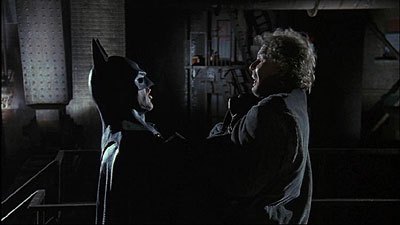
But as Bruce Wayne, Keaton doesn't seem right. The aloof nature is there, but smooth, he is not. The funny thing is, I always considered him to be the best of the bunch, but since Batman Begins, he doesn't stack up as well. I think it's something about his voice that makes him sound more like a high-school teacher than the Dark Knight, at least when he isn't camouflaged with the cowl.
Opposite Keaton, Jack Nicholson turned in a fantastic performance as The Joker, grounding the character in reality, at least as grounded as a white-faced, homicidal clown can be. Incredibly, it's over a half-hour before he even appears as the villain, yet he still is an overwhelming presence on the film. This might be the most turned-loose performance the noted wild man ever gave, set free by the make-up, costume and psychotically funny disposition. Nicholson so fully became the Joker that his performance became iconic, the kind of role that defines a film and a character, despite decades of history behind it.
The supporting cast surrounding Keaton and Nicholson is good, starting with Robert Wuhl as a pesky reporter, Kim Basinger as Bruce's love interest Vicki Vale and Michael Gough as Alfred. Truthfully, no one stands out, other than Jack Palance as gang kingpin Grissom, a part I had previously forgotten, but when you've got an acting battle royale like the one between Keaton and Nicholson, why waste time on anyone else.
In the hands of Burton, and Oscar-winning designer Anton Furst, Gotham City became as important a character as those played by actors, with the mix of gothic and art-deco design (and a splash of Burton's favorite German expressionist look) creating an original and dramatic backdrop for the action and drama. By crashing the style of two distinct time periods, a classic, beautiful and timeless feel is accomplished. It's as close to a certainty as anything that there will never be an ugly film made by Tim Burton.
Batman Returns
When it came time for a sequel to Batman, the question to be answered was, how do you top such a massive success? In Batman Returns, the answer would be double the villain count, add Christopher Walken to the mix and put Michelle Pfeiffer in tight black leather. It seems to have worked, as Burton took these new ingredients and made a fascinatingly quirky story about outsiders and the lengths that society pushes them to.
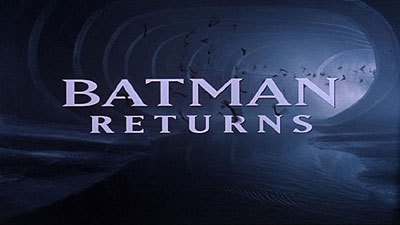
Since Batman was well-established after the first film, more attention could be given to the villains, the part of the mythos that's always been one of the most attractive factors of the character. The choices were good ones, representing the good and the very, very ugly.
Picking Catwoman as one was a stroke of obvious genius, as the direction chosen ramped up the film's sex appeal, and gave Batman a wonderful foil to battle and fall for. Filling the role with Pfeiffer was even better, as she made Catwoman a being of incredible sexual energy and pure insanity. Because of that, she is practically a mirror image of the Bat, just a bit cracked...and much better looking in a cowl.
The other third of the super-triangle is The Penguin, as portrayed disgustingly by Danny DeVito. In Burton's hands, his outsider status is made exceedingly evident through physical deformities and an appearance that's pure freak-show. Though he's certainly villainous, there's a sympathetic side to his character that's a trademark of the director's best work.
While Catwoman and Penguin give Batman a run for his money, the rich are the real problem in Gotham City, just as it is in real life. As industrialist Max Shreck, Christopher Walken gets to be the creep he plays so well. His part is tailor-made for a Burton movie, balancing between cartoonish villain and realistic evil.
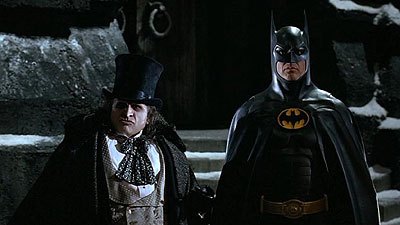
It's that balance that this film did better than the first movie. Playing the relationship between Batman and Catwoman against a burgeoning romance between their alter egos, gets to the heart of what makes superheroes so interesting. Their secret lives are so much a part of who they are, but are often under utilized as story devices. This film gets more out of it than the rest of the films in the series. It doesn't hurt that it grows into some intensely sexy moments.
Overall, the second film installment of Batman does a nice job of building on the first film and making some improvements to the formula, though the camp that fills the third and fourth films raises its head in small doses. It was essentially impossible to top the first film, so going in a slightly different direction was a smart move, as it resulted in a very memorable movie. Considering the ease with which Burton puts together these dark films with a bit of candy-coloring, one wonders what he would do with a Dick Tracy film.
Batman Forever
Lost somewhere between the greatness of Batman and the garbage that is Batman & Robin, is Joel Schumacher's first Batman movie, Batman Forever. While not the awful film that the fourth film is, it was so very different from the Burton era that it caused an adverse allergic reaction in viewers (at least those older than 11.) It was an unfortunate side-effect, as this version actually features the best cast of the first four.
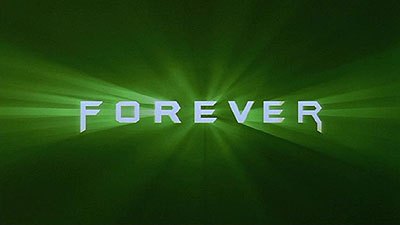
Batman is now played by Val Kilmer, who is excellent as the billionaire Bruce Wayne, but feels a bit too over-the-top in his part as the growling crime-fighter. Kilmer is more than capable of being dark and brooding, but like Keaton's Wayne, there's something that's just not right. Either way, he was a good choice to lead the film, even if he doesn't do much more than fight.
Thinking about the villains in this movie, Two-Face (Tommy Lee Jones) and The Riddler (Jim Carrey), I realized that the storyline since the first film has become increasingly unimportant in comparison to letting the bad guys do their thing. Here, two good actors are allowed to run rampage over the screen, displaying more bombast than technique, and because of that, they take over the film. It's not so much what they do, but how they do it: loud, especially Carrey, who turns his part into a showcase for his wilder side.
The "hot chick" role is filled by Nicole Kidman this time, though she's just a regular girl; one who jokes about costumes and weapons, instead of using them. As a psychology expert, she opens up the opportunity to further explore the concept that was in the previous movie, but this film doesn't do much thinking, so the opportunity falls away. But she does keep things hot with her own love triangle with Bruce and the Bat, and that's all that the film really asks of her.
Schumacher took the film in a very different direction mainly by lightening the city of Gotham, adding neon lighting anywhere he could, and turning his characters into stand-up comedians. There are more one-liners in this film than there are in a season of the '60s Batman TV series, which induces more groans than laughs. He also slapped a pair of nipples onto the Batsuit, which, along with the rest of Batman's leather and vinyl fetishes, brings into question what Bruce's off-hour interests are.
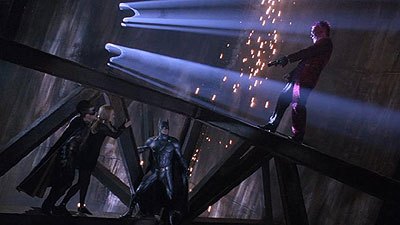
Schumacher may have answered that by introducing a character that's seemingly intended to serve as an entry-point for teens: Robin. As played by Chris O'Donnell, Robin is an annoying teen, feeling misunderstood and full of disdain for the world at large, complete with an earring that shows he's a rebel, like the millions of other earring-wearing rebels out there. Why Bruce would even put up with him is a question that will have to carry over into the future, as even the film itself doesn't have the patience to fully deal with the Boy Wonder.
Combine all of these concerns with a sensibility aiming directly for a pre-teen boys' piggy bank, and the movie ends up as a disappointment for older fans of the character, despite a wealth of promise and a movie that's visually appealing. This film is still a good time, but would have been more enjoyable if it wasn't a Batman movie, freeing it of the related expectations.
Batman & Robin
I can say, without hesitation or reservation, that this film is one of the worst ever released by a major studio, and certainly the worst Batman film. Just about every part of this film, from the script and acting to the directing and special effects, is of a quality that would embarrass high-school drama productions.
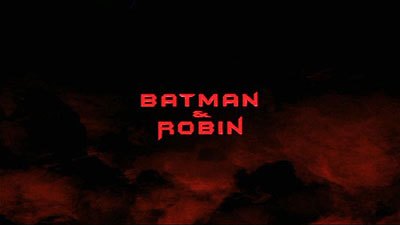
George Clooney dons the cowl for this adventure, bringing the suave, debonair Cary Grant-like style needed to play Bruce Wayne, but falling short when wearing the mask of Batman. Not that there's much Batman to play. The film is dominated by Mr. Freeze, a second-rate bad guy played with awful gusto by Arnold Schwarzenegger. I can't remember a line the character said that wasn't some awful pun about ice, snow, cold, etc... If he delivered them with something close to acting skill, it wouldn't be so bad, but every one is said with a snarl as if the performance was being hampered by constipation.
The only part of this film that's at all entertaining is Uma Thurman, who channels Mae West in her vampy role as the movie's femme fatale, Poison Ivy. Because she's so good at playing this campy part, matching the best villainy that Eartha Kitt ever displayed as Catwoman, the rest of the acting seems downright awful, especially the performances by Chris O'Donnell as Robin and and Alicia Silverstone as Alfred's niece, Barbara. Silverstone may have the worst delivery of any line in the Batman franchise, toward the end of the film, which is an accomplishment.
The cast was not helped by Oscar winner Akiva Goldsman, whose script is mind-bogglingly terrible, mistaking cheesy one-liners for proper dialogue. Even in the climactic moment of the film, where an attempt at emotion is made, the film pulls out another pathetic joke. In what might be a worse sin, the film treats the Bruce Wayne portion of the Batman mythos as an afterthought. The idea of the dual identity is key to the character, and it's almost like a burden here, weighed down by the pointless relationship with the no-dimensional Julie Madison (Elle Macpherson). Considering the film is two hours long, there was plenty of time to give to Wayne, but instead, he's filler.
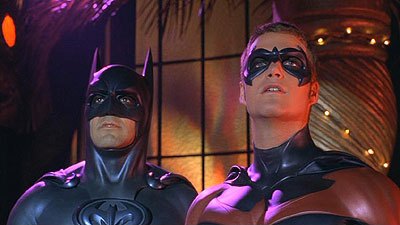
As entertaining as the '60s Batman series was, you can't recapture that campy feel and try to maintain the look of the Burton films, which is what it feels like Batman & Robin is doing. To attempt to "have it both ways" is going to end up badly every time, and it certainly does so in this film. But what Schumacher thought he was doing with this movie is not important. What's key is what ended up on-screen, and that's a bad movie.
There are many questionable choices, like the odd ass and crotch close-ups during the heroes suit-up scenes and why the costumes still needed nipples, including Batgirl's, and as a result, overall, the film feels more like a parody than a Batman movie. Action scenes are shot without impact, and end up looking like bad stage fighting, as the attempts at wirework and large battles, namely the hockey fight, feel almost amateurish. But considering the overall package, why should it have been any different?
The DVDs
For the Region 1 release, the poster art, slightly altered and branded for the set, is used on each case, whereas the Region 2 release has much more stylish icons on its covers. On the other hand, the Region 2 case is more obvious than the North American version, with pictures of the four cases.
The Region 1 outer case has a serious wow-factor working for it. A three-piece case, the top part is die-cut to reveal the Batman logo and to give it the feel of the Batman costume, showing a shiny foil inner sleeve. The sleeve sits in the bottom of the case, and holds the four single-width keepcases, one for each film, which hold two discs each, using a tray for the second platter. There are no inserts. I'm not big on having box sets on my shelf, but this one has earned a spot.
The first disc of each set holds the film itself, and has an anamorphic widescreen main menu that follows the same style as the Batman Begins DVD. The menu choices include play movie, select scenes, view special features and adjust languages. Scene selection menus include animated previews and titles for each chapter, while the language options are English 5.1 (in Dolby Digital and DTS) and French 5.1, while subtitles are available in English, French and Spanish. The discs are also closed captioned.
The Quality
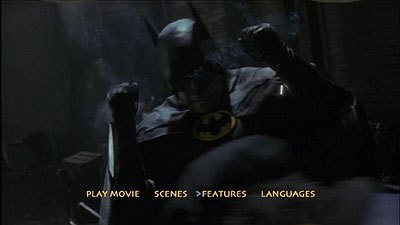
Batman
The first film, naturally the oldest, starts off looking a little rough, with jittery titles and the slightest amount of grain, but once the movie gets going, it is an incredible improvement over the original DVD. Despite how dark the film is, the anamorphic widescreen transfer presents it in crystal-clear quality, with excellent detail and beautiful color. Any scene with the Joker, and his purple and orange costume, is particularly nice looking, as the colors are appropriate instead of garish.
The only real problem with the transfer is the fact that the quality is too high for the level of the technology at the time. Any animated imagery, even the smallest piece, is extremely obvious, which almost takes you out of the movie.
The audio is available in two flavors, Dolby Digital and DTS 5.1, as is the case on all four films. This is an older film, and the mix isn't particularly aggressive, but it does a nice job of delivering the action. The DTS feels like it has just a slight bit more weight to it, but it's not overwhelmingly better, while both have clean music and dialogue.
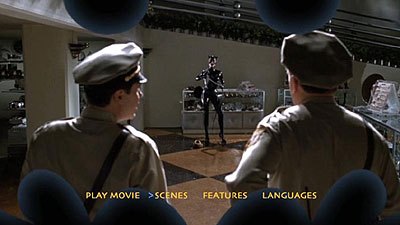
Batman Returns
The anamorphic widescreen transfer on this film feels bit tighter than the first film's, but that may be due to the difference in age. This film has a harsher feel, thanks to the different settings, and the transfer gets that feel across well with a dark, aggressively clean look. Thinking about the brightness of the Penguin's toxic sludge or the light in the department store explosion makes me feel like this is as good as this non-HD material can look.
The DTS track on this film is an excellent reason to pick up a receiver with a DTS decoder, if you don't have one. The mix moves throughout the soundfield with some serious strength, presenting a listening experience you'll realize you've been missing all this time. It's funny when you revisit a film from the time before extreme theater sound for the first time, and see how far movie sound has come in such a short amount of time.
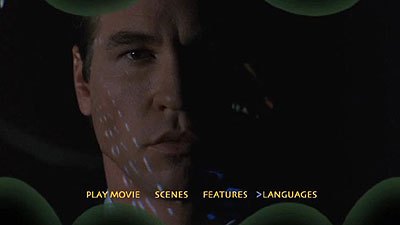
Batman Forever
This film looks positively beautiful in this transfer. If you want to see just how good it can look, check out the first time The Riddler tries out his invention. The level of detail is exceedingly high, while the color is just about perfect, including gorgeous skintones. If there's something wrong with the look of this film, I can't find it, aside from some very minor specks of dirt and the way the clarity reveals the matte paintings.
Aurally, the film is very powerful, with the DTS track pounding out the strong score and many sound effects. The actors' voices come across crystal clear, with an impressive depth to the whole show. Flip back and forth between the two 5.1 tracks during Robin's street fight an hour in to see and hear how good this movie presentation is.
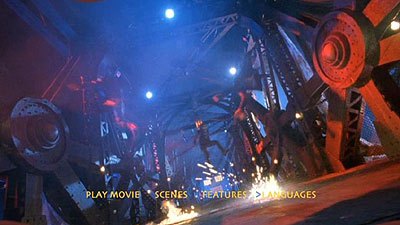
Batman & Robin
Ironically, the worst of the four films looks and sounds the best. That it's the most recent obviously helps, but anyone who's seen the first DVD knows it could look awful. This new anamorphic widescreen transfer is excellent, displaying the film's excessive special effects crisply. Mr. Freeze's ice effects looked pretty bad on the previous release, but here they have the proper icy quality. The plant effects still look cheesy, but they are undoubtedly clean. Color is very strong on this disc, and the level of detail is high.
The Extras
Batman
Here's what fans of this film have been waiting for for almost a decade. Disc One has two extras, one being the film's theatrical trailer, which shows how far the art of the preview has come since 1989, and a feature-length audio commentary by Tim Burton. Burton is soft-spoken, but extremely informative, giving an essential background to the movie, as only a true auteur could. It may have taken a while, but the wait was well worth it to get a commentary this good.
The second DVD holds the majority of the extras, and there's not a bit of wasted space. The effort put forth here is on par with any retrospective DVD we've yet to see, as there isn't a member of the production that isn't heard from on this disc, as long as it was possible (not having Prince on board was a guarantee with a Warner Brothers product.) I don't think I've seen a disc before that actually involved people who have had a negative experience or who have had legal battles over the material.
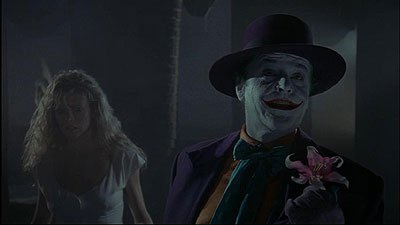
The immense effort begins with "Legends of the Dark Knight: The History of Batman," a 40-minute look back of the character, from the page to the small screen to the big screen and everywhere else. An impressive roster of participants, including Harlan Ellison, Frank Miller, Kevin Smith, and Stan Lee, put the character into historical context and talk about what makes Batman the cultural icon he is.
There's a tremendous amount of history covered, even some that might only appeal to comic fanboys. The only disappointment is the limited coverage the '60s TV show gets, including no interview with Adam West. Unfortunately, that is likely influenced by the legal problems between Fox and Warner Brothers over the series.
That excellent documentary is followed by the first three parts of an even more detailed six-part documentary, "Shadows of the Bat: The Cinematic Saga of the Dark Knight," which focuses on the Batman films. There isn't a piece of the film franchise that isn't covered in this documentary, of which 71 minutes are included here in "The Road to Gotham City," "The Gathering Storm," and "The Legend Reborn." Anyone with an interest in this film absolutely needs to watch this documentary to learn the entire story of the series.
Yet another documentary of impressive depth, "Beyond Batman" runs over 50 minutes, and examines the work that went into the look and sound of the film. A ton of interviews with the cast, crew members and decision makers, and plenty of production documents and behind-the-scene photos and footage give a comprehensive view of the work that went into this incredibly atmospheric movie.
The rest of the disc pales in comparison to the documentaries in terms of the pure depth, but it's still an entertaining time. An older promotional piece for the film, "On the Set with Bob Kane," mixes some clips from the film with on-set footage of Kane and an interview with the character's creator. It's short, but has historic value and seems like something most people probably have never seen before.
When I saw there were profiles of the heroes and villains, I expected text pieces like the ones on the Batman Begins DVD. Instead, there are nearly 20 minutes of interesting looks at the characters, on the page and on the screen, made up of interviews with a wide variety of people with a connection with the characters and the actors in the film. Warner has got to be given credit, as they didn't cut pieces about actors being cut from the films. Sure, there's no one flat out cursing the studio's name, but normally, even references to such matters get left out of DVDs.
"Batman: The Complete Robin Storyboard Sequence" is one of those extras you only see on DVDs that are made by a producer who truly "gets it." Instead of just offering a gallery of storyboards to thumb through with your remote, the abandoned introduction of the Boy Wonder is shown with animated storyboards. But, not only are they animated, they have full sound effects, music and voices, with the leads provided by a pair of "Batman: The Animated Series" veterans: Kevin Conroy as Batman and Mark Hamill as the Joker. It's a presentation that goes well beyond the norm.
As a youngster, the Batman soundtrack helped to turn me into a huge Prince fan, so it was pretty exciting to see a trio of his videos appear on this DVD. "Batdance" is probably the most well-known of the group, and is definitely the video I best remember, simply because of how bizarre it is, and the many dancing Bat-tie-ins, including Prince in a half-Batman/half-Joker costume and an army of Vicki Vales. "Scandalous" has no connection visually to the film, but is the best of the three songs, while Prince returns to play the Joker in the video for "Partyman," a song featured prominently in the film. There's no artistic greatness in these videos, but any Prince fan will be happy to own them.
Batman Returns
The first DVD follows the same set-up as that of Batman, providing a theatrical trailer and another feature-length audio commentary by Burton. Having handled the basics of his time with the character in his first commentary, Burton is able to focus on the details of this film and his thoughts about the two films, along with some interesting revelations. Once again, he isn't likely to rouse anyone from their slumber, but the track is one of the more informative solo commentaries I've heard recently.
The first featurette, the 22-minute "The Bat, the Cat and the Penguin," is an old studio promo made for television, hosted by Robert Urich. It's nowhere as in-depth as the other materials, and is actually pretty cheesy at times, but there are some good interview clips with Burton, DeVito, Pfeiffer and Keaton, as well as some interesting on-the-set footage. Seeing Keaton clown around with Burton while wearing the Batsuit and watching Pfeiffer work on her whip technique makes this a surprisingly worthwhile inclusion on the disc.
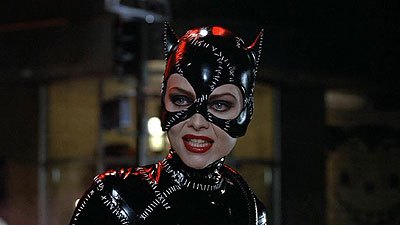
The fourth part of the "Shadows of the Bat" documentary, "Dark Side of the Night," spends 30 minutes on the second entry into the franchise and the shift in tone from the first movie. It's a great continuation of the storyline, and includes plenty of information that hasn't been heard before regarding the behind-the-scenes issues surrounding the movie.
Another installment of "Beyond Batman" is included, this time looking at the construction of the second film. Running 15 minutes longer than the first edition, this version has a stand-out piece titled "Inside the Elfman Studio," which deconstructs the score of the film, as each character had their own music. Elfman even gives a demonstration of how he scored Batman Returns. The featurette as a whole is an excellent behind-the-scenes look at the movie.
19 more minutes of Hero and Villain profiles are found on this DVD, looking at Batman, Alfred and the new bad guys, while a music video is included for this film as well, though it's one I've never seen before. I can't say I remember the song "Face to Face" by Siouxsie and the Banshees, but the video is heavily based on the film, going with a Catwoman theme. It's not likely something you'll watch more than once, unless you're a big Siouxsie fan.
The extras are obviously much slimmer this time out, but with the reach of the the first film's bonus material, the risk of repetition was certainly there.
Batman Forever
On the first disc, the theatrical trailer provides an unintentional bit of comedy, as O'Donnell delivers a line that speaks to every critic of the film. That it wraps up the trailer is a purely coincidental nice touch.
A feature-length audio commentary by Joel Schumacher does a fine job of explaining the madness behind his method, giving a reason for just about every decision made, even discussing the controversial Batnippples. No one knows if these points were his true motivation, as he's had plenty of time to come up with a good story if they weren't, but at least it feels like he had a purpose in dead-ending the series, because he certainly has no reverence for the character. When he isn't explaining, the track takes detours into compliments for the actors and crew and the usual talking about what's on-screen.
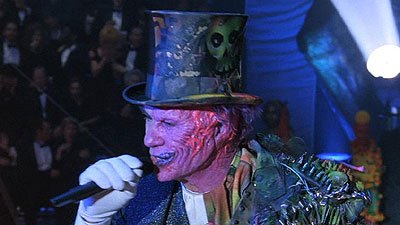
Another made-for-TV special, "Riddle Me This: Why is Batman Forever?," is hosted by O'Donnell, with the same promotional cheesiness as Urich's, and contains interviews with Kilmer, Schumacher, Carrey, Jones and Kidman, and includes plenty of on-set footage. The 24-minute show feels much more like a commercial than the show created to promote the second film, and doesn't have the same level of production quality. Simply put, it's just not as fun, coming off as an extended "Access Hollywood" piece.
The fifth part of "Shadows of the Bat," the 28-minute "Reinventing the Hero," has new interviews with those involved (Jones and Kidman appear in archival footage), focusing on the change from the Burton Batman to the Schumacher version. The participants are careful with their words, focusing on the positives of each director, though O'Donnell actually expresses a dislike for Returns. The focus on the business aspect is a bit off-putting for any fan of the character, but it's a part of the overall story because it lead to the fourth film, and thus had to be told.
More profiles, 16 minutes in all, cover Batman, Robin, Dr. Chase Meridian, The Riddler and Two-Face, while the third "Beyond Batman" documentary fills in the production blanks for the third movie. That it is a shorter piece at 45 minutes, a half-hour less than the Returns featurette, is surprising, considering the focus placed on the visuals in this film. There's basically an entirely new crew on-board for the third film, which means an entirely new style, from the design to the special effects to the music, which provides plenty of opportunities to provide new information.
For the first time in the anthology, deleted scenes are included, which can be viewed separately, or all at once. There's some odd stuff in here, including a scene with transvestites and a scene name that's ridiculous, but there's one that actually ended up being explored in Batman Begins, which would have improved the film. In truth though, it hardly fits with the rest of the film, as it actually takes the character seriously. There's just under 14 minutes of footage here.
The disc wraps up with another music video, this time "Kiss From a Rose," by Seal. A complete Bat-tie-in, its a great song, but a less-than-inspired clip show, centered around Seal singing in front of the Bat-signal. The lack of the more creative U2 video for "Hold Me, Thrill Me, Kiss Me, Kill Me" is a disappointment.
Batman & Robin
The set is 4-for-4 in terms of consistency, delivering a trailer and commentary on Disc One, as Schumacher discusses the intricacies of this cinematic debacle. It's mostly more of the same, though the stories are less interesting, and often repetitive.
As a commentator, he's a bit on the dry side, though considering he knows he is speaking to a hostile crowd, he is making a wise decision in not overstating his thoughts. The most interesting part of the commentary is the doubt Schumacher had in the process. The corporate control over the film is a big problem, as Schumacher basically admits he was an employee making a movie that he didn't believe in. Again, full credit to Warner Brothers for allowing this to be heard.
The sixth part of "Shadows of the Bat," the 27-minute "Batman Unbound" finishes up the documentary's look at the first four films, on a definite down note. The participants, (Schwarzenegger, Thurman and Clooney appear via EPK footage), are honest about the film's failures in their new interviews, taking about the demands of toy companies and corporate overseers. Interestingly, the piece provides two different stories about the casting change from Kilmer to Clooney, which is rare for a corporate release.
"Shadows of the Bat" ends up running almost three hours long, though it lacks an ending. Considering this anthology is being released on the same day as Batman Begins, it would have been nice to include a part seven on that DVD looking at the downtime between this film and the newest one, but at the end of the day, it's an excellent overview of the series.
The final installment of "Beyond Batman" looks at the production effort on the final film, an intensely visual movie. In 50 minutes, the piece covers the design, vehicles, costume, make-up and visual effects. Interestingly, there's nothing about the music this time around. These four documentaries provide just about everything anyone would want to know about creating the look and feel of a movie.
A deleted scene, "Alfred's Lost Love," changes the relationship between Bruce's manservant and Barbara, and is better left deleted, as it added nothing to the film.
The largest group of music videos in the anthology is found here, with four in total. The Smashing Pumpkins' "The End is the Beginning is the End" is a standard band-in-front-of-clips video, but the song isn't half bad. Of course, seeing Billy "Mr. Freeze" Corgan in skin-tight black wasn't on my wish list. The other three, "Look Into My Eyes" by Bone Thugs-N-Harmony, "Gotham City" by R. Kelly, and "Foolish Games" by Jewel, aren't songs I remember well, and Jewel's doesn't even have a connection to the film. It's obvious it took some digging to fill out this DVD, which wraps up with 17 more minutes of Hero and Villain profiles for Batman, Robin, Batgirl, Mr. Freeze, Poison Ivy and Bane.
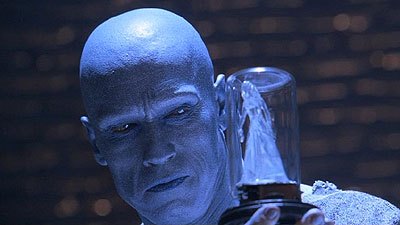
The Bottom Line
In just a scant four films, the franchise made a 180-degree turn from the engaging, vital Batman, a film that rejuvenated the character, into a bloated parody that essentially killed the series for eight years. As great a film as Batman is, filled with creativity and excitement, the final film is an utter disaster. Because of its presence in this box set, the quality takes a bit of a hit, but like "The The Karate Kid Collection," if you're a fan, you'll grab them. And like the Karate Kid set, it's priced in a way where you can convince yourself you didn't pay for that last film. But if you really want, you can just pick up the films you want separately.
As far as the DVDs are concerned, the presentation for each film is excellent, and a tremendous step up from the original discs. Plus, the bonus features, especially the six-part "Shadows of the Bat" documentary, show a real effort to capture the history of the films and not just fill disc space with whatever EPK footage was lying around. I'll even give extra credit to Schumacher for sitting down to talk about films that aren't exactly fan favorites. It's rarely the case that a studio bomb gets a critical treatment from that studio, but in this Anthology, it's all covered, giving fans the comprehensive, dare I say, Criterion-like collection they've been waiting for for at least 10 years. I was tempted to knock this set down a peg thanks to the last film, but it really does belong in the DVDTalk Collectors Series.
Francis Rizzo III is a native Long Islander, where he works in academia. In his spare time, he enjoys watching hockey, writing and spending time with his wife, daughter and puppy.Follow him on Twitter
*The Reviewer's Bias section is an attempt to help readers use the review to its best effect. By knowing where the reviewer's biases lie on the film's subject matter, one can read the review with the right mindset.
|
| Popular Reviews |
| Sponsored Links |
|
|
| Sponsored Links |
|
|
| Release List | Reviews | Shop | Newsletter | Forum | DVD Giveaways | Blu-Ray | Advertise |
|
Copyright 2024 DVDTalk.com All Rights Reserved. Legal Info, Privacy Policy, Terms of Use,
Manage Preferences,
Your Privacy Choices | |||||||









